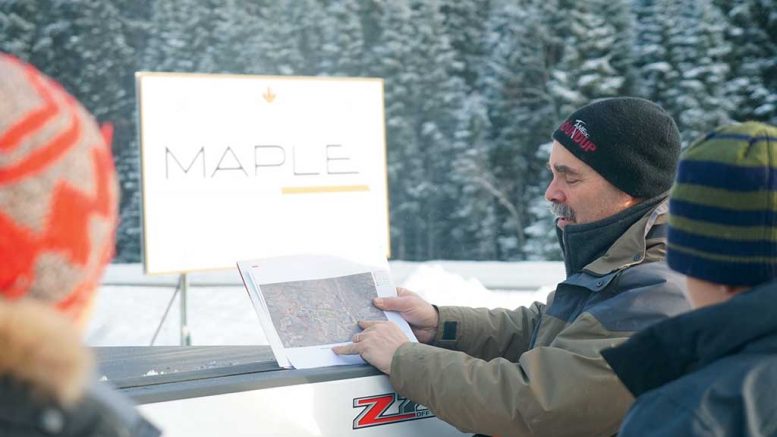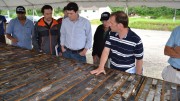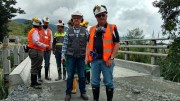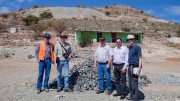AMOS, QUEBEC — Over the last four decades, a series of owners have carved out a resource of nearly three million ounces of gold below the 30 metres of overburden that blankets the Douay project in the Abitibi greenstone belt of northwestern Quebec.
But the structures controlling the distribution of that gold — 2.8 million inferred ounces from 83.33 million tonnes grading 1.05 grams gold per tonne — remains largely a mystery.
“It’s complex structurally — I don’t think there’s been a really concerted effort to try to understand what controls the gold mineralization,” Fred Speidel, Maple Gold Mines’ (TSXV: MGM; US-OTC: MGMLF) new vice-president of exploration, says on a recent tour of the property. Speidel and his colleagues at Maple Gold Mines are determined to find out.
The junior has assembled a world-class team — several of whom, like its new president and CEO Matthew Hornor — cut their teeth working for Robert Friedland’s Ivanhoe group.
Hornor spent more than a decade within the Ivanhoe family of companies and has brought with him Ivanhoe alumni David Broughton as a director and head of Maple Gold Mines’ technical committee, along with Jay Chmelauskas, as chairman.
Broughton worked for Ivanplats (now Ivanhoe Mines [TSX: IVN; NYSE: IVN]) from January 2008 through October 2016 and was co-awarded PDAC’s Thayer Lindsley and AME’s Colin Spence awards for world-class discoveries at Kamoa in the Democratic Republic of the Congo and Flatreef in South Africa.
Chmelauskas headed up Jinshan Gold Mines for five years in China’s Inner Mongolia region, before Ivanhoe sold its 42% stake in the company to China National Gold Group, in 2008. The mining executive, who prior to Maple Gold Mines was CEO of Western Lithium before its merger with Lithium Americas, continues to work on special projects for the Ivanhoe private equity arm HPX.

A historic headframe at Maple Gold Mines’ Douay gold property in northern Quebec. Credit: Maple Gold Mines.
“We come from the Ivanhoe world where excellence was demanded every second of the day,” says Hornor. “We’re occupying every single position with the most excellent of people to make sure this thing is a screaming success.”
And like Ivanhoe, the culture at Maple Gold Mines is to embrace trial and error as a necessary part of making discoveries.
“You have to have an open mind, you have to be prepared to let people test targets,” Broughton tells analysts and investors attending a tour of Douay in November. “I was given that opportunity when I was working for Ivanhoe in places like South Africa and Congo. Those deposits wouldn’t have been found if we hadn’t taken that approach, of saying, ‘Let’s be creative, let’s drill some wildcat holes,’ and that’s how success happened.”
In this case, the company has a good head start. There’s an archive of more than 220,000 metres of historic drill core to interpret that dates to the initial Douay discovery by Inco Gold in 1976. The core is in excellent condition and the site even has a headframe built by Aurizon Mines in the 1990s and never used.
“We’ve already got 3 million ounces here more or less in-pit, and it’s much larger if you can un-constrain it, so we’re well on the way to having something that is viable and with a lot of upside still to come,” Broughton says. “You’ve got this huge land package, you’ve got new ideas and people coming in, and it’s really exciting because you can make discoveries when you’re in that situation.”
While there is a lot that is unknown about Douay and its surrounding 370-sq.-km land package, what Speidel and Broughton do know is that the majority of the gold found there, so far, is associated with a syenite gold system that forms part of a 7-km-long trend of mineralized zones. These zones are found within the central part of the project’s 55 km of strike length along the Casa Berardi Deformation Zone.
The intrusive-related style of mineralization is also present at several other gold deposits that have been recently discovered, such as Canadian Malartic, now owned by Agnico Eagle Mines (TSX: AEM; NYSE: AEM) and Yamana Gold (TSX: YRI; NYSE: AUY), about 157 km to the south of Douay, Osisko Mining’s (TSX: OSK) Windfall project, between Val-d’Or and Chibougamau in the Abitibi, and Alamos Gold’s (TSX: AGI; NYSE: AGI) Young-Davidson mine, 60 km west of Kirkland Lake in northern Ontario.
Closer to home, Douay is 81 km to the east of Hecla Mining’s (NYSE: HL) Casa Berardi gold mine and 123 km to the southeast of Detour Gold’s (TSX: DGC) Detour Lake gold mine. Past-producing gold mines in the high-rent neighbourhood include Sleeping Giant, an orogenic gold deposit 50 km to the south, and Selbaie, a volcanogenic massive sulphide (VMS) deposit, 66 km to the north.
The interesting thing about the region along the Casa Berardi break, Speidel says, is that it contains a variety of deposit types in addition to syenite-related gold systems. There are VMS deposits — sulphides that accumulated on the sea floor that can be rich in copper, zinc, lead and gold. There are orogenic gold deposits — the more typical quartz-gold veins — such as the Casa Berardi and the Sleeping Giant mines.
Elsewhere in the Quebec portion of the Abitibi Greenstone belt there are other intrusive-related gold systems, similar to Douay, such as Lac Shortt, Metanor Resources’ (TSXV: MTO) Bachelor Lake mine, and Malartic, which are associated with alkaline intrusives or intrusive complexes, including carbonatites, such as is the case at Douay and Lac Shortt. (Lac Shortt, 165 km east of Douay, was a small gold mine that produced 2.7 million tonnes grading 4.6 grams gold and operated for six years, closing in 1990.)
“One of the things that I was really impressed about here is that we’re sitting in a system where there are half-a-dozen different types of gold deposits, all associated, more or less, with the Casa Berardi break,” Broughton says. “It’s not just intrusive-hosted gold. There are other opportunities here under cover. The Sleeping Giant mine has past production and resources of about 1.3 million ounces of gold at very high grades. It’s sitting just to the south of us, adjacent to the same splay that runs through the southern part of our property, so why couldn’t there be those sorts of things here? We certainly have high-grade intersections.”
Meanwhile, Canadian Malartic is a very similar deposit type to Douay, as it’s also associated with felsic to intermediate porphyritic rocks that are borderline alkaline, Speidel says.
“We use Malartic as a model and in the remote spectral geology study we’re currently doing, we’re using Malartic as a calibration site to look for similar signatures at Douay, because it’s a big open pit and the spectral response is fairly obvious.”
“I’m really interested in these intrusive-related gold systems because of things like Malartic,” Broughton says. “These give you an opportunity to bulk mine what probably 25 years ago you couldn’t have done, and put together large deposits with a lot of ounces. And certainly since I left the Abitibi and come back, that’s happened in Timmins in a couple of places, and now at Malartic, and I think it can happen here. So I want to look at these styles of systems. How do we find them? What do they look like under cover because we are sitting on a lot of cover here and it’s not about what we see, it’s about what we don’t see.”
Intrusive-related systems like Malartic are typically large-tonnage, low-grade and amenable to open-pit mining and they weren’t on anyone’s radar until fairly recently, Broughton says, adding that in his early career he was used to thinking of the Abitibi as having Hollinger-type gold quartz veins. “These are different,” he says of the intrusive-related systems.
“They’re disseminated gold mineralization. So if you look at the core and you walk around, you don’t see many veins and you don’t see much visible gold. It’s a very different gold mineralization than the better known style, and that has implications for exploration.”
Broughton notes that intrusive-related gold systems are usually associated with relatively small intrusions, syenitic in composition, and are generally oxidized, which means they often have magnetite or hematite, which means there are geophysical implications in terms of detecting them.
“If you look at a map of the Abitibi, you’ve got very large areas of igneous rocks, of plutonic rocks, big, big granites, and so on. And that’s not what we’re talking about here. We’re talking about small little porphyry systems that come off much larger ones, in a similar way as what you see if you go to British Columbia and you look at the systems at places like Red Chris. So you’re not looking for these large masses. They’re actually quite small targets, but they can, obviously, be very attractive.”
The geologist also notes that they tend to be smaller intrusions, often later in age, and associated with what are known as Temiskaming-type sediments in the Abitibi. The intrusions also like to come up on faults, he says, which means they’re often on geological boundaries between mafic and sedimentary packages.
“If you look at Malartic, the mineralized zones that they’re mining are largely to the south of the main structure, the Cadillac-Larder break, and actually in sedimentary rocks,” Broughton says. “At Douay, it’s in mafic rocks and that has implications again on what these things look like geophysically and geochemically. So there are lots of things we can use under cover to try to understand targeting.”
Over the last 18 months, Maple Gold has re-logged much of the historic core. Since joining the company in late 2017, Speidel started examining 27,000 metres of core that had yet to be re-logged. His goal: To characterize gold mineralization associated with clusters of higher grade and broader gold intercepts and select high quality targets for the company’s 2018 drill campaign.

The core storage facilities and buildings at Maple Gold Mines’ Douay gold project in Quebec. Credit: Maple Gold Mines.
The 25,000-30,000-metre drill program will kick off on Jan. 15 and include reverse circulation (RC) and diamond drilling in brownfield and greenfield areas. About 50% of the program will test potential new discovery targets, including diamond drilling of the Northeast syenite target and top-of-bedrock RC drilling of additional greenfields targets. The remainder of the program will consist of step-out and infill drilling the existing resource.
In addition to improving geological and exploration models from the re-logging work, the company plans to test a significant amount of the historic core that was never assayed for gold. An initial 8,000 samples have already been collected, and during the final phase of re-logging, another 10,000 samples will be collected. The new assays will help identify mineralization vectors and improve geo-statistical modelling of the resource.
Given that much of the project over the Casa Berardi Deformation Zone is covered by thick glacial deposits, conventional soil sampling is ineffective at targeting bedrock anomalies.
“We want to update the geological model and then update the block model,” Speidel says. “It seems that sometimes, as may have been the case here, the two models are developed with a degree of independence from each other, rather than using your geological model to constrain your block model. So we want to fix that.”
So far early re-logging work has found evidence that when there is higher grade material (anything over a gram gold), there will be a significant structure within a few tens of metres of it, Speidel says, and there is an association that needs to be defined between the syenite, favorable mafic wall rocks and structures.
“The old logs may indicate that there’s a fault zone here, there’s a shear zone there, there’s a fracture zone over there, but no one has really tried to pull it all together in terms of what this actually means and which structures may be more relevant, because they’re not all the same,” he explains. “We want to understand what controls the higher grades of gold within the sections we’re logging, but ultimately we want to get a 3-D model of the structural situation that we have. I’ve done some re-logging myself because I have to understand the rocks and contribute my own ideas about the whole system.”
“That’s an important point,” Broughton chimes in. “I was recently in Africa for two weeks and other than travel time and one day in the office, I spent my time in the field and logging core. If you can’t get your senior people logging core, and they’re pushing paper, you’re not getting value.”
For Speidel, whose career started in northern Quebec, working in the Abitibi is a homecoming of sorts. In his early days the geologist was responsible for brownfield exploration around Lac Shortt. He also played a role in the discovery of the Troilus gold deposit, 120 km north of Chibougamau. Inmet Mining produced over 2 million oz. gold and almost 70,000 tonnes copper from an open pit at Troilus between 1996 and 2010.
Troilus was originally thought to be a shear zone-hosted gold system but turned out to be intrusive-related. And like the early days at Douay, people thought of Troilus as a potential underground project and discounted the lower grade material. “Troilus was sitting on the shelf and the person running the exploration office for Minova at the time thought outside of the box and said, ‘Think open pit.’ So he passed the project to me and we did a bunch of drilling, and we ended up redefining the model as more of a porphyry kind of gold system.”
The average grade at Troilus was around 1 gram, but there was a feeder zone at depth in the pit that was double the grade … Douay has potential for multiple feeders and certainly that’s what it looks like when you plot out the gold accumulations.”
Later, while leading exploration teams in Central and South America for Minnova, which later became Inmet Mining, and then was acquired by First Quantum Minerals (TSX: FM; LON: FQM), Speidel was involved in several gold and copper discoveries, including Cobre Panama, the enormous copper development project in Panama.
Prior to joining Maple Gold Mines, he was regional exploration manager in North America for Antofagasta (LON: ANTO; US-OTC: ANFGY).
”David and I both started in the Abitibi and then went international so we can come back and apply different thinking,” Speidel says. “We haven’t been in the Abitibi for most of our lives so some of the methodologies that we’ve used elsewhere are applicable but not commonly used around here, like remote spectral geology, for instance, and a few other things.”
“Coming back to this area for me is exciting because of the time gap,” Broughton adds, noting that after starting in the Abitibi more than 30 years ago, he spent the following two decades in Africa. “When you come back and you’ve forgotten your preconceived ideas you can bring in new ideas,” he says. “And you can ask questions that maybe other people don’t ask and do things that other people maybe don’t do and that’s a great way to make discoveries.”
The geologists also agree that the common perception of the area around Douay is that there is nothing left to find, an attitude that Speidel recalls encountering when he wanted his previous employers to let him look for deposits in Chile. “People would say, ‘It’s a mature country for exploration and the land is all staked and you won’t find anything.’ And I would say, ‘Well, it’s mature in some belts, and it’s mature from zero down to 400 metres, but it’s not mature below 400 metres depth.”

Examining maps at Maple Gold Mines’ Douay gold project in Quebec, from left: David Broughton, director and head of the technical committee; Fred Speidel, vice-president of exploration; and Matthew Hornor, president and CEO. Credit: Maple Gold Mines.
“A lot of my career in a lot of cases has been going into places which were felt to be of little interest,” Broughton adds. “People didn’t think there was much potential, and we were successful. That happened at Platreef in South Africa and it certainly happened at Kamoa and at other places, as well, and this is another example of really a whole district that has kind of been forgotten or written off by a lot of people. It’s sometimes not what you see but what you don’t see, and I think there’s a lot of truth in that here.”
The Douay resource remains open along strike and down plunge, and the company believes brownfields exploration potential for resource expansion is excellent. The deepest hole was drilled to 958 metres; the average hole depth for the current 761-hole database is 293 metres.
“Abitibi systems are mesothermal, mid-crustal systems that have tremendous depth extent,” Broughton notes. “I worked underground at Kerr-Addison, 4,500 feet below surface. Macassa is 8,000. These things go a long way down. Douay has few holes below 700 metres. And so to me, there’s a lot of down- plunge extent that we will need to bear in mind when we’re doing our exploration.”
Currently, Douay’s pit-constrained resource is contained in eight separate zones: 10, 20, 531, Central, Douay West, Northwest, Porphyry and Main.
The Main zone averages 1.5 grams gold per tonne, Douay West 2.36 grams gold, the Northwest zone 2.15 grams, and the larger Porphyry zone around 1 gram. The smallest zones (10, 20, and Central) average 1.2 grams gold.
The distance between the Main and Douay West zone is about 6.6 km end to end.
The company has also defined a new zone it is calling the Northeast syenite target, which is 6 km by 1 km, and virtually untested by drilling. The target is about 2.6 km to the northeast of the Porphyry zone and Maple Gold plans to drill a minimum of 11 core holes into the target in the first quarter of 2018.
In the Porphyry zone, there are at least four clusters of higher-grade intersections, at greater than 2 grams gold per tonne, and Speidel surmises they could represent structural intersections or feeder zone, particularly in the up-dip areas where there are potential starter pits.
Highlights of the company’s 2017 spring-summer drill program include 9 metres of 4.53 grams gold, including 1.5 metres of 15.7 grams gold in the central segment of the Porphyry zone and 1.2 metres averaging 13.35 grams gold. In the Douay West Zone, drilling returned a 7.5 metre intercept of 1.39 grams gold, 20.6 metres of 2.11 grams gold and 23.1 metres of 2.20 grams gold.
Previous drill campaigns returned 21.18 grams over 10.5 metres; 9.27 grams gold over 21.4 metres in Douay West; 14.41 grams gold over 16.9 metres in the Main zone; 2.63 grams gold over 55.7 metres in the 531 zone; and 2.13 grams gold over 60 metres in the Porphyry zone.
“We’ve expanded the area of syenite to roughly ten kilometres, that’s the brownfields target area right now, but even outside of that, along what looks to be the north strand of the Casa Berardi fault zone, there are a number of other areas that have syenite, and there’s very little drilling that’s been done out there so there’s quite a lot of upside potential in terms of finding additional resource clusters all along the Casa Berardi fault zone and secondary structures,” says chairman Chemelauskas.
“This team is following the discovery model, not the finance model, and that means we’re telling our geologists ‘don’t be afraid,’” adds Pierre Lebel, who sits on the company’s board of directors and was awarded Mining Person of the Year in 2012 by the Mining Association of British Columbia for his contribution to mine development in British Columbia. “We’re not going to blame anyone for taking a chance and not getting a good result because we know that we’re not going to get results every time and we’re going to drill some dry holes.”
“So often junior companies have a financing model in their approach – they don’t want to get too far away from the known, and instead nibble around the edges, and it takes so long when you do it that way. You eventually get there, but this team really has a different attitude.”
In the meantime, Maple Gold’s executives are criss-crossing the globe marketing the story.
“A big part of what we’re doing here is putting this company in play,” Chmelauskas says, adding that the company has recruited Gregg Orr, a former partner at Deloitte, as its chief financial officer, to bring the company’s financials into shape.
“Matthew is doing laps of the world talking to people … and Gregg has brought our financials up to that senior company standard, so when Matt brings in his Japanese colleagues that want to buy into this business — or any of the intermediate or senior companies that we expect to pass this company on to — we’re ready for them today.”
Hornor, who speaks fluent Japanese and honed his skills at Ivanhoe where he negotiated project financings for development projects with international banking syndicates, structured strategic alliances and directly negotiated equity raises of more than $450 million, is enjoying the challenge.
“My job is the fun one — I get to talk about a stock with great potential that trades for only a quarter today — so I’m having a great time,” says Hornor.
At press time in Toronto the company was trading at 24¢ per share within a 52-week range of 15¢ (December 2016) and 46¢ (March 2017).
The junior has 182 million total shares outstanding for a market cap of $44 million.






This article has been edited. It used to say ““My job is the fun one — I get to talk about a $2.50 stock that trades for only a quarter today — so I’m having a great time,” says Hornor.
Why the change? What else in this article has been edited?
Hi Patrick, the quote in the online version of the story was changed at the company’s request due to their concern it violated corporate disclosure guidelines. The original quote was published in the Jan. 8 print edition of the newspaper.
Thank you for clearing that up Trish! All the best!